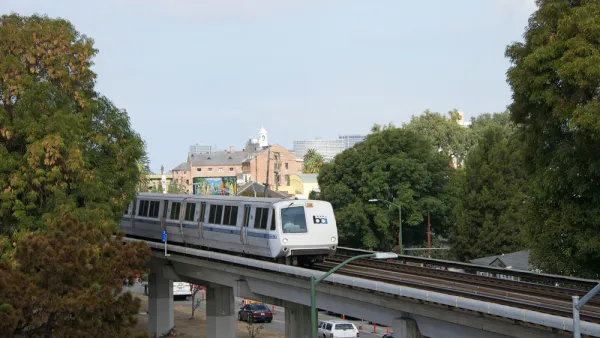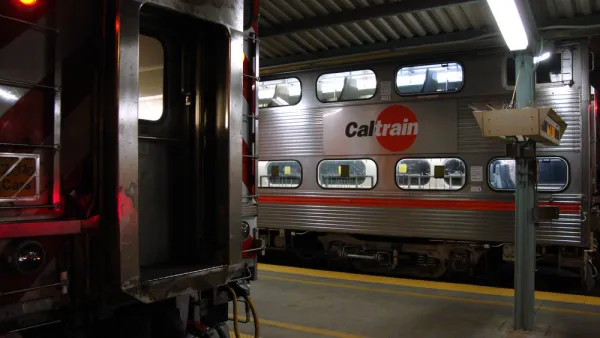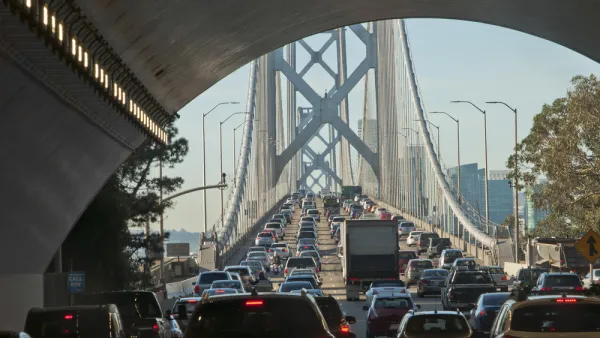Gov. Jerry Brown, Peninsula congresswomen, including House Minority Leader Nancy Pelosi, and state legislative leaders gathered in Millbrae with shovels-in hands to mark the beginning of a four-year construction project to electrify Caltrain.
“A country is great when it can come together and build for the future," stated Gov. Brown to the invited guests on July 21 that had come to the Caltrain–BART station in northern San Mateo County to celebrate the groundbreaking of the 51-mile, $1.98 billion Peninsula Corridor Electrification Project. "That’s what we’re doing right here on the Peninsula.”
The project's future looked uncertain after the state's GOP House delegation wrote Transportation Secretary Elaine Chao in February to defer the $647 million capital investment grant, not because they opposed electrification of the commuter rail line but because the track would be shared by California High-Speed Rail, the focus of their animus.
Chao complied, and Caltrain was forced to spend $20 million to extend construction contracts that had already been signed, with no guarantee that a federal full funding grant agreement would be signed by Chao.
State leaders, including the governor, the congressional delegation, including three representatives shown in the photo at Friday's ceremony, and business leaders lobbied hard to get Chao to change her mind, which she did in May.
In addition to the environmental benefits of greatly reducing (but not eliminating for reasons explained below) carbon and criteria pollutant emissions, including toxic diesel particle pollution, electrification is projected to expand "capacity from its current 65,000 weekday riders to 110,000 passengers," reports Samantha Weigel for The Daily Journal.
More work, more funds needed
Carl Guardino, CEO of the Silicon Valley Leadership Group, remarked on how the work is not over as noted additional money is needed to replace all of Caltrain’s crowded diesel cars with electric locomotives.
Yes, by early 2021,16 new, Swiss-built (assembled in Utah) Stadler double-decker electric multiple-unit trains, each composed of six cars, will be transporting passengers to and from Silicon Valley and San Francisco, and all Peninsula cities in between. However, that will still leave 25 percent of Caltrain's existing diesel locomotives in operation, reports Weigel.
The state legislature is considering three bills that would benefit Caltrain:
- SB 797 by Sen. Jerry Hill (D-San Mateo) would directly help Caltrain with a one-eighth-cent sales tax to be paid by residents of the three counties in the Caltrain corridor: San Francisco, San Mateo, and Santa Clara, subject to supermajority approval by the electorate.
- SB 595 by Sen. Jim Beall (D-San Jose), also known as Regional Measure 3, would permit voters in all nine Bay Area counties to increase tolls on the seven state-owned Bay Area toll bridges, subject to a majority threshold. While Caltrain would likely receive some funding, it is intended to primarily benefit trans-bay commutes.
- AB 1613 by Assemblyman Kevin Mullin (D-So.S.F.) would fund transportation projects in San Mateo County via a half-cent sales tax subject to supermajority approval by voters.
All three bills are aiming for their funding options to be placed on the ballot next year. First they have to clear the legislature and be signed by the governor.
One downside of the electrification project that weekend travelers that weekend travelers noticed on July 15 is that the Saturday and Sunday schedules were curtailed 22 percent and 25 percent respectively.
The bottom line goes to Assemblyman Kevin Mullin, who stated at the ceremony: "Electrification builds the foundation for the future." Indeed!
FULL STORY: Officials celebrate Caltrain electrification project start

National Parks Layoffs Will Cause Communities to Lose Billions
Thousands of essential park workers were laid off this week, just before the busy spring break season.

Retro-silient?: America’s First “Eco-burb,” The Woodlands Turns 50
A master-planned community north of Houston offers lessons on green infrastructure and resilient design, but falls short of its founder’s lofty affordability and walkability goals.

Delivering for America Plan Will Downgrade Mail Service in at Least 49.5 Percent of Zip Codes
Republican and Democrat lawmakers criticize the plan for its disproportionate negative impact on rural communities.

Test News Post 1
This is a summary

Test News Headline 46
Test for the image on the front page.

Balancing Bombs and Butterflies: How the National Guard Protects a Rare Species
The National Guard at Fort Indiantown Gap uses GIS technology and land management strategies to balance military training with conservation efforts, ensuring the survival of the rare eastern regal fritillary butterfly.
Urban Design for Planners 1: Software Tools
This six-course series explores essential urban design concepts using open source software and equips planners with the tools they need to participate fully in the urban design process.
Planning for Universal Design
Learn the tools for implementing Universal Design in planning regulations.
EMC Planning Group, Inc.
Planetizen
Planetizen
Mpact (formerly Rail~Volution)
Great Falls Development Authority, Inc.
HUDs Office of Policy Development and Research
NYU Wagner Graduate School of Public Service





























